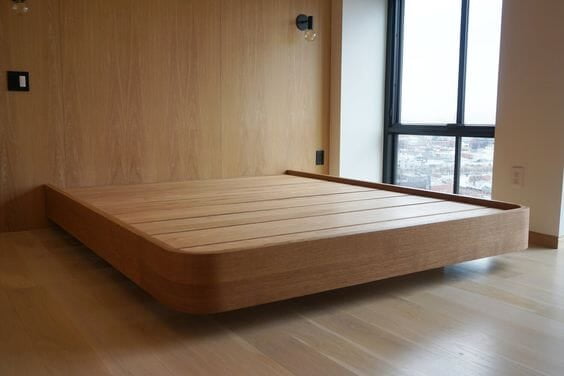Introduction
When it comes to choosing the most suitable material for making a bed, several factors must be considered, including durability, comfort, aesthetics, and cost. The bed is a crucial piece of furniture in any home, and selecting the right material can significantly impact your sleep quality and overall bedroom ambiance. In this detailed guide, we’ll explore various materials commonly used for bed construction, examining their benefits and drawbacks to help you make an informed decision.

1. Solid Wood
Overview
Solid wood is a traditional and highly regarded material for bed frames. It is known for its durability, natural beauty, and timeless appeal. Common types of wood used include oak, maple, cherry, and walnut.
Benefits
- Durability: Solid wood is strong and can last for many years with proper care.
- Aesthetics: Offers a natural, elegant look that can complement various interior styles.
- Customization: Can be easily stained, painted, or finished to match your decor.
Drawbacks
- Cost: Typically more expensive than other materials.
- Maintenance: Requires regular maintenance to prevent damage from moisture and scratches.
- Weight: Can be heavy and difficult to move.
Best For:
Those seeking a high-quality, durable, and aesthetically pleasing bed frame with a classic look.
2. Engineered Wood (MDF and Plywood)
Overview
Engineered wood products, such as Medium-Density Fiberboard (MDF) and plywood, are popular choices for bed frames due to their affordability and versatility. These materials are made from wood fibers or layers glued together, offering a stable and cost-effective alternative to solid wood.
Benefits
- Cost-Effective: Generally less expensive than solid wood.
- Flexibility: Can be shaped and finished in various styles and designs.
- Consistency: Provides a smooth surface that is less likely to warp.
Drawbacks
- Durability: Can be less durable than solid wood, especially in high-moisture environments.
- Weight Capacity: May not support as much weight as solid wood.
- Finish: Can be prone to scratches and dents, though it can be covered with veneers.
Best For:
Budget-conscious individuals looking for versatile and customizable bed frames that offer a modern look.
3. Metal
Overview
Metal bed frames are known for their durability, sleek design, and low maintenance. They come in various finishes, including steel, iron, and aluminum, and can range from minimalist to ornate styles.
Benefits
- Durability: Metal frames are highly durable and resistant to wear and tear.
- Maintenance: Easy to clean and maintain, requiring only occasional dusting.
- Design: Available in a wide range of designs and finishes, from modern to vintage.
Drawbacks
- Comfort: May not offer the same warmth and comfort as wood.
- Noise: Can sometimes creak or make noise with movement.
- Coldness: Metal can feel cold and less inviting compared to wood.
Best For:
Those looking for a durable, easy-to-maintain bed frame with a modern or industrial aesthetic.
4. Upholstered Beds
Overview
Upholstered beds feature a soft fabric or leather covering, often padded for added comfort. They can be constructed with wooden or metal frames beneath the upholstery.
Benefits
- Comfort: Provides a plush, comfortable look and feel, often including padded headboards.
- Aesthetic Variety: Available in numerous fabrics, colors, and patterns to match various decor styles.
- Noise Reduction: Upholstery can help reduce noise from the bed frame.
Drawbacks
- Maintenance: Fabric can be prone to stains and may require special cleaning.
- Durability: Upholstered beds can be less durable than solid wood or metal, particularly in high-traffic areas.
- Cost: Can be more expensive due to the cost of upholstery materials.
Best For:
Individuals seeking a stylish, comfortable bed frame with a luxurious appearance.
5. Platform Beds
Overview
Platform beds feature a low-profile design with a solid base or slats that support the mattress. They are often made from wood or metal and can be minimalist or feature storage options.
Benefits
- Modern Design: Offers a contemporary, sleek appearance.
- No Box Spring Needed: Supports the mattress directly, eliminating the need for a box spring.
- Storage Options: Some designs include built-in storage drawers or compartments.
Drawbacks
- Height: Lower profile may not be suitable for everyone, particularly those with mobility issues.
- Support: Depending on the design, may not offer as much support as traditional bed frames.
Best For:
Those looking for a modern, space-saving bed frame with a minimalist or functional design.
6. Adjustable Beds
Overview
Adjustable beds allow for customizable positions, including raising the head or foot of the bed. They are typically made from a combination of materials, including metal and fabric.
Benefits
- Customization: Offers various positions for enhanced comfort and health benefits.
- Convenience: Ideal for individuals with medical conditions or those who prefer adjustable settings.
Drawbacks
- Cost: Generally more expensive than traditional bed frames.
- Complexity: Requires additional components and can be more complex to set up and maintain.
Best For:
Individuals seeking flexibility and customizable positions for health or comfort reasons.
Choosing the Right Material
When selecting the most suitable material for your bed, consider the following factors:
- Budget: Determine how much you are willing to spend, as this will influence your material options.
- Design Preferences: Choose a material that complements your interior decor and personal style.
- Durability Needs: Consider how long you want the bed to last and how much wear and tear it will experience.
- Comfort: Think about how comfortable you want the bed to be, including factors like padding and warmth.
Conclusion
The most suitable material for making a bed depends on various factors, including your budget, design preferences, and durability requirements. Whether you opt for the classic elegance of solid wood, the versatility of engineered wood, the sleekness of metal, the comfort of upholstered beds, the modern appeal of platform beds, or the functionality of adjustable beds, each material offers distinct benefits and drawbacks.
By understanding the characteristics of each material and considering your specific needs, you can make an informed decision that ensures you get a bed frame that not only looks great but also stands up to the demands of daily use. Explore your options, weigh the pros and cons, and choose the material that best suits your style and functional requirements.
For more guidance on bed materials and furniture choices, stay tuned to our blog and reach out to industry experts for personalized advice and recommendations.






